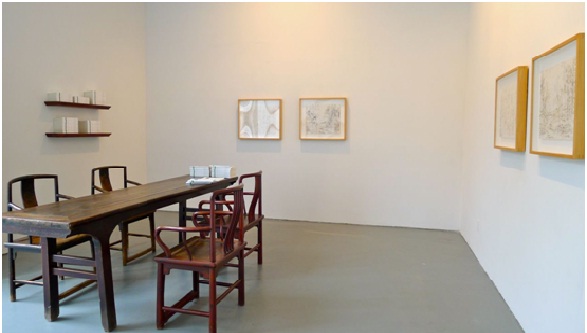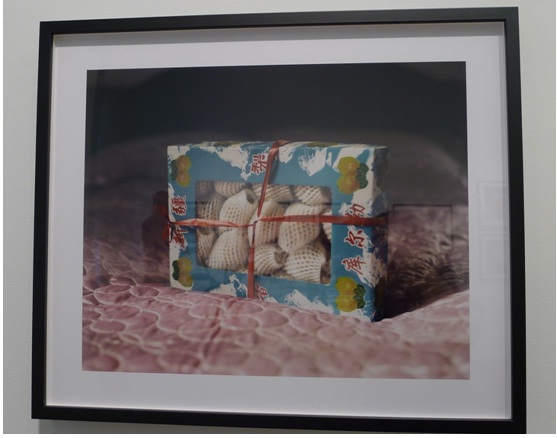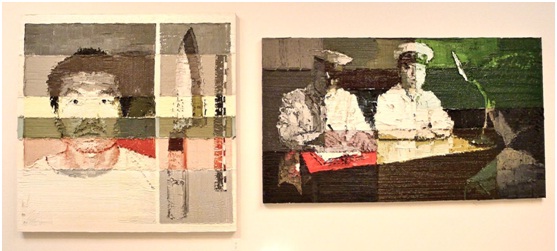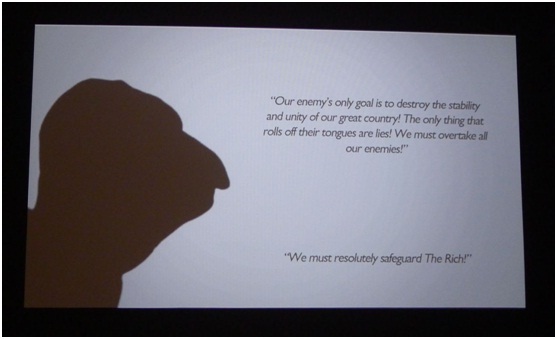藝評
Chinese art in Chelsea: a June fourth excursion
彭綺雲
at 1:18pm on 11th June 2011





Captions:
1. Wang Tiande. 3,720: Recent Works by Wang Tiande. Photo credit: tinaypang. Wang Tiande 2011.
2. Shen Wei. Xinjiang Pears, Shanghai, 2010. Photo credit: tinaypang. Shen Wei 2010.
3. Li Songsong. Public Enemy. Oil on canvas. Photo credit: tinaypang. Li Songsong 2008.
4. Cao Fei. East Wind (video still). Photo credit: tinaypang. Cao Fei 2011.
5. Cao Fei. Shadow Life (film stills). Photo credit: tinaypang. Cao Fei 2011.
June fourth in New York, where there were no visible reminders of the events of this day twelve years ago, I went to Chelsea wondering what, if any, Chinese art would be on view, and whether the works translate in a place used to the giants of modern and contemporary art.
The four exhibitions considered here throw up their own questions that will be offered in turn. How much of a responsibility does a curator or gallerist have to make an artist legible to their audiences? How contemporary can ink painting be if it is not abstract? These questions rang loudly when viewing Wang Tiande’s latest exhibition at Chambers Fine Art. Known for his Digital Series, in which ink painting landscapes are overlaid with characters and images burnt out of Chinese xuan paper, this installation presents works in the same idiom but filtered through the device of a short novel that Wang conceived while artist in residence at the University of Kansas in March 2009, this incidentally is home of the Chinese art historian Li Chu-tsing who taught Wan Qingli. The title of the exhibition: 3,720: Recent Works by Wang Tiande (3,720: 王天德近作), is the number of steps that he counted between his home and a nearby park and the novel is the story of Wang’s fictional alter ego, Lin Wai, a journalist whose life is described as mirroring that of millions of Chinese citizens adapting to post Socialist China.
The installation features a reading room where viewers can read the resulting novel, but as it is printed only in Chinese, this potential for interaction is restricted only to those literate in the language. But this question of legibility reaches further into the exhibition with the images seeming to bear little relation to Wang’s putting-into-words of a narrative often used in presenting Chinese art outside of China. A more serious question to raise is: what could this story offer in reflecting anything other than a single artist’s musing upon the random nature of life?
Despite the achievements of Wang’s complex multi-layered works, the sense of formal and cultural dissonance on the edges of New York’s rich and ambitious art district rang loudly. Chinese landscapes in ink on paper–regardless of the attempt at deconstruction–lean so far back into antiquity that in reaching for the now, they still fall far short of contemporaneity.
Stephen Burks exhibition at New York’s Museum of Arts and Design poses the question Are You a hybrid? The title seems irrelevant in a world in which many of us are physically, by virtue of travel or heredity, and virtually, by means of technology, open to influences that are ‘other’. Shen Wei’s photography resolves this question with neither angst nor confrontation. Shen is an artist who perhaps does not benefit from being discussed in a review that artificially groups together artists of Chinese origin being shown in New York. Born in Shanghai but based in New York, Shen’s work can be seen in two different exhibitions in New York that should be considered together. In Chinese Sentiment at Daniel Cooney Fine Art, the artist addresses the condition of being Chinese only as it relates to his own lived experience, specifically visits that he made to China between 2008 and 2010, with a sensitive and fresh eye. The range of work on view highlights some of Shen’s considerable strengths.
In recent years, the depiction of Chinese landscape in photography has shown the influence of artists such as Edward Burtynsky and Allan Sekula, who use the cool gaze of the lens to cast a critical eye on man’s relationship with, and attempt to manipulate nature. Such images, whether intentionally or not, are also becoming commentaries on the subject of illegal land seizures and the pace of development, a growing source of rural and urban unrest in China. Shen’s relationship to his subjects, in landscape and still lifes seems distanced as if that of a huaqiao (華橋) or overseas Chinese, not quite a tourist’s gaze, but finding interest in images that betray an outsider’s romantic tendencies.
His still lifes have a haunting contrary quality. Nostalgic in subject matter, but evidently modern in approach and composition, these are his best works, and can be seen to greater advantage in Shen’s Table Setting as part of Aperture Foundation’s five-artist commission Moveable Feast: Fresh Produce and the NYC Green Cart Program at the City Museum of New York. Sharply composed and saturated in colour these possess the hyper-reality of Dutch and Flemish still life paintings, generating a similar discomfort with their intensity of sensual experience offered up to the eye. Shen’s portraits have a similarly candid and intimate quality that speak so much to an actual lived relationship that they inspire some of the discomfort and voyeurism that the renowned photographer Diane Arbus confronted her viewers with.
Photography also figures in the work of Li Songsong and Cao Fei, to differing degrees. Li Songsong’s first solo exhibition in the US at Pace Gallery features eleven works modelled on photographic images, often capturing an historical moment or political mood. Li is known for transforming such photographic moments into large abstracted paintings thick with discipline, texture and materiality. In this exhibition, Li is beginning to introduce subjects that move away from the easily recognisable iconic images to focus more on the shared conflicts that these situations may address, with an emphasis on the thing-ness of his works. The distance that this method of practice instils, as noted by Barbara Pollack in the catalogue, is a visual vocabulary shared with artists such as Chuck Close in his dissected portraits.
Works such as Pig Years (2010) are so monumental in scale that they require the considerable space of the gallery to even make sense of the image distorted. Others like Couple (2011) recall a time of projected innocence reminiscent of the joyful simplicity of the artist Feng Zikai’s (1898–1975) world. There are also those that address more directly the darker side of image-making. Public enemy (2008) creates a narrative structure by pairing together a suspect’s arrest record with his subsequent interrogation.
Cao Fei, known mostly for her work in the virtual world of second life, offers a deceptively engaging approach to thinking about contemporary China in Play Time at Lombard Freid Projects. In this four-part installation comprising a model of a skate park, courtyard garden and photographic images, shadow-play film, and a video, Cao takes the viewer (as child) by the hand on a journey into a world where the idyll of play is threatened by a dull yet looming fate. Standing alone, the skate park model is an invitation to play, with skateboards that can be moved around the park.
Playing with known children’s characters, Thomas the Tank Engine and the BBC’s CBeebies, Cao has created a film (East Wind) and photographic series (PostGarden) that inserts this visual trope for the child into situations that act as a commentary on current social conditions in China, and critique the seemier side of capitalist endeavour. The gallery’s courtyard has been transformed into the PostGarden of the title of this series, but cannot be entered and the window through which you can view it is high enough to mimic the experience of a child straining to see something that is off limits.
Shadow Life is a mesmerising use of a complex art form in telling China’s recent histories. Executed entirely using hand gestures in shadow play, the film is divided into three chapters, (A Rock, Dictator, and Transmigration) that escalates from a simple child’s morality-tale-like form, to a darker political critique, ending in a spiritual or philosophical reckoning. Hauntingly enhanced with three soundtracks that evoke the mood of each chapter, this is a powerful and memorable work.
The day left me excited to see Chinese artists examining their own practice and motivations in making work that are multi-lingual in addressing the concerns and experiences of contemporary life today.
Exhibition: 3,720: Recent Works by Wang Tiande
Date: 5.5.2011 – 25.6.2011
Venue: Chambers Fine Art, New York
Website: http://www.chambersfineart.com/exhibitions/2011.shtml
Exhibition: Shen Wei: Chinese Sentiment
Date: 14.4.2011 – 4.6.2011
Venue: Daniel Cooney Fine Art, New York
Website: http://www.danielcooneyfineart.com/wei_photography.html
Exhibition: Li Songsong
Date: 6.5.2011 – 5.8.2011
Venue: The Pace Gallery, New York
Website: http://thepacegallery.com
Exhibition: Cao Fei: Play Time
Date: 18.5.2011 – 25.6.2011
Venue: Lombard Freid Projects, New York
Website: http://www.lombard-freid.com/home.htm
Exhibition: Stephen Burks: Are You a Hybrid?
Date: 3.5.2011 – 2.10.2011
Venue: Museum of Arts and Design, New York
Website: http://www.madmuseum.org
